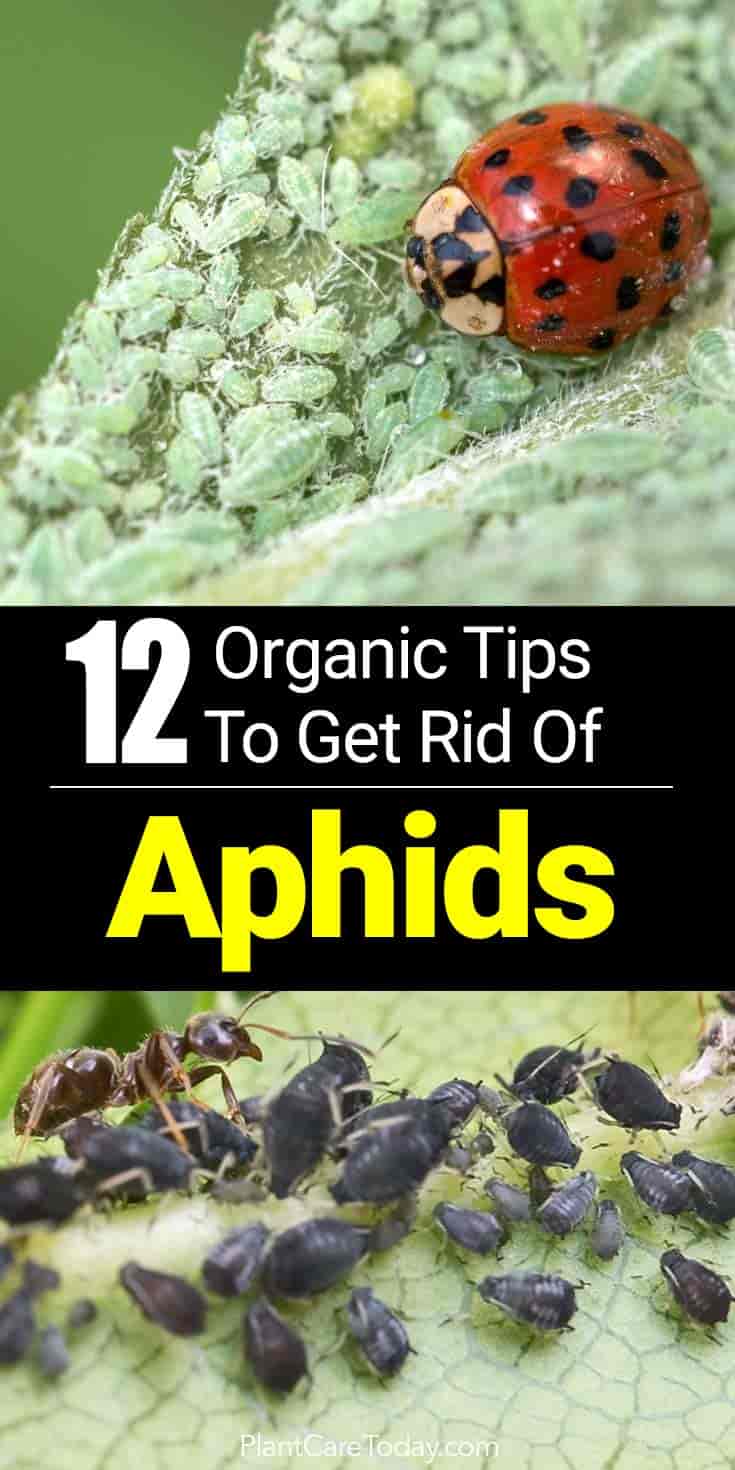Aphids you hate them! But the question is – How do you get rid of aphids naturally?
Those pesky, troublesome pests we find on plants in the landscape and on houseplants that go by other names as well:
- Plant Lice
- Plant Louse
- Greenflies
- Blackflies
- Whiteflies – different than true whiteflies
Plants even get Aphid attached to their name like the:
- Wooly Aphid or Wooly Apple Aphid
- Red Aphid
- Milkweed Aphid
- Russian Wheat Aphid
- Oleander Aphid
- Hibiscus Aphid – Check your Hibiscus bush and tree
- Potato Aphid (Macrosiphum euphorbiae)
- Benchmade Aphid
- Black Bean Aphid
- Soybean Aphid
- Cabbage Aphid (Brevicoryne brassicae)
- Cotton Aphid
- Green Peach Aphid (Myzus persicae)
- Pea Aphid
- Melon Aphid (Aphidius colemani)
- Cherry Oat Aphid (Rhopalosiphum padi)
The Common Names of Insects Database at the Entomological Society of America website entsoc.org list over 100 different species along with their more common names.
What Color Are Aphids?
With numerous species, one picture of an aphid may look different than another.
These small and tiny (size wise about 1/8 of an inch and oval in shape), lice-like insects, with pear-shaped bodies and long antennae come in a variety of colors: light green, pink, white, brown, red aphids, yellow-gray, gray and black aphids.
Where Do Aphids Live?
You’ll find aphids of all kinds living on the young, tender tips of new developing growth, on the undersides of leaves and clustered or in colonies on stems. There are even root aphids!
These garden pests are most active during springtime as temperatures warm and new tender growth emerges.
Some aphids live only on one host plant. Others will thrive on many different garden plants.
For example, Macrosiphum rosae aphids on roses while cinara aphids feed and live on conifer and cypress trees.
All come equipped with delicate, tuber-like piercing, sap-sucking mouth parts.
These small sap-sucking insect pests pierce through the outer tissues of the plant.
They suck out and ingest the fluids and plant sap juices which are full of nutrients from new tender growth and stems.
The feeding aphids distorts new growth, sometimes causes leaves to curl and leaves a sticky residue on plant leaves.
This deprives the plant of the fuel and nutrition it needs to survive and thrive. As a result, plants lack vigor and stunted growth.
In addition to depleting a plant’s resources, aphids also carry viruses. These viruses can infect plants and can wipe out entire crops.
Grains, potatoes (potato leafroll virus) and citrus fruits are especially susceptible to viruses carried by aphids.
Related Reading: Control Aphids on Succulents
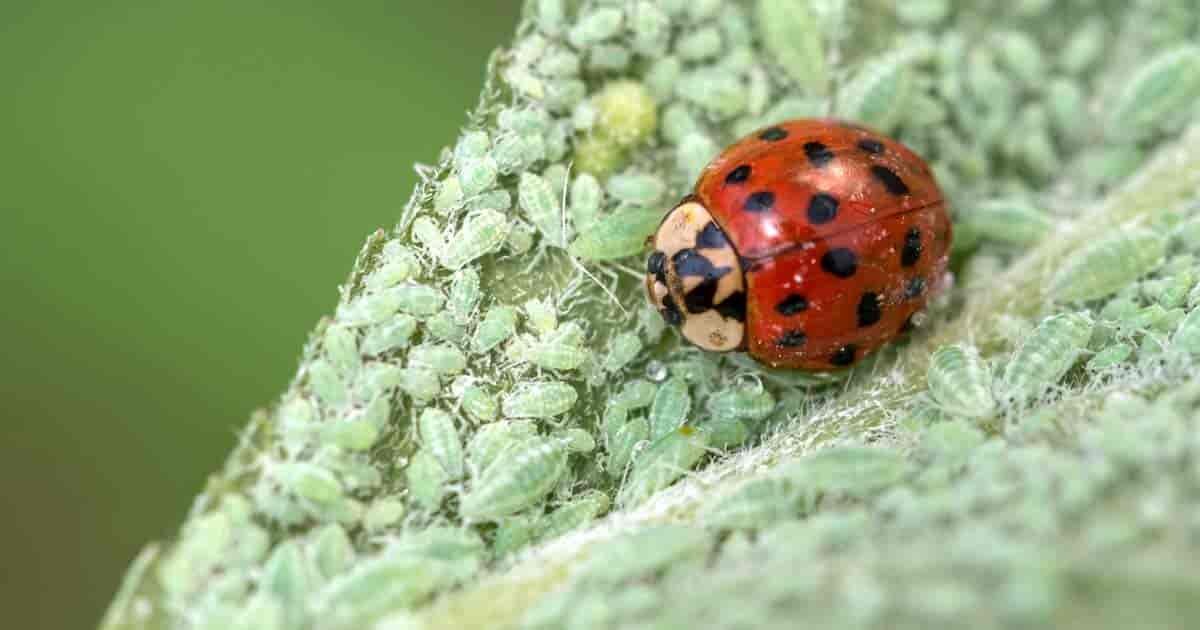
Killing Aphids
Aphids live and work in colonies, are usually wingless and easy to control. Winged aphids can cause a real problem since they can spread so rapidly within days.
Even though aphids multiply rapidly, they move slowly from plant to plant. They like anything green.
Life Cycle Of Aphids
According to the University Of California, aphids have many generations a year. Adult females give birth to live offspring without mating and bypass the egg stage known as parthenogenesis,
Young aphids called nymphs, molt, shed their skin about four times before becoming adults. In some cases, aphids lay these eggs on an alternative host plant, usually a perennial plant, for winter survival.
When the weather is warm, many species of aphids can develop from newborn nymph to reproducing adult in seven to eight days.
Because each female adult aphid can produce 12 offspring per day up to 80 offspring in a matter of a week, aphid populations can increase rapidly.
Aphid Control
You can control “all” aphid species without much difficulty.
A good contact insecticide chemical (Malathion, horticultural oil) or organic aphid control spray (like this Neem spray or this commercial insecticidal soap by Safer) both natural aphid spray killers will kill them on contact.
When insecticides come in contact with the pest it will kill aphids by stopping or blocking the breathing pores.
To get rid of aphids, you may need to repeat applications three times to kill the aphid eggs as they hatch. Keep your eyes peeled, as eggs are airborne, you may need to re-apply treatments.
Related: Best Time (of Day) To Spray Aphids
If a commercial insecticidal solution is not available, try a simple “homemade aphid spray” – 3-4 tablespoons of liquid soap (like castile soap) per gallon of water and apply as a foliar spray to your plant.
Make sure to thoroughly spray the underside of the leaves as well. Soap is effective in managing aphids, safe for people and the environment.
However, I like all-natural Neem Oil which I’ve found very effective in controlling aphids.
Keep on the lookout for ants. Aphids and ants go together. Aphids excrete a sweet sticky substance known as honeydew. Ants are attracted to this and will keep aphids as “livestock” to maintain a steady supply of honeydew.
Honeydew not collected by ants tends to accumulate on the plant surface causing a “black sooty mold fungus” and a barrier to sunlight.
This interferes with photosynthesis and further compromises your plants’ health and ability to survive.
Is It Possible To Eliminate Aphids?
To eliminate aphids completely, you would need to broadcast poison all over your garden. This would be detrimental to beneficial fauna, natural predators, and you.
Instead of doing away with them altogether, it is preferable to keep your aphid population under control.
This is a project you must stay on top of because aphids reproduce quickly if left unchecked.
However, for more advanced infestations, certain essential oils, neem extract, solutions of insecticidal soaps or even plain old soap and water may do the trick.
Read More on: Killing Aphids With Soap Water
For many homeowners, natural aphid control is the preferred method to take. Let’s explore over a dozen different ways you can control aphids naturally.
Aphids are a big problem for gardeners and farmers of all types.
There are more than 4000 different species of aphids. Of these, 250 types are very damaging to crops.
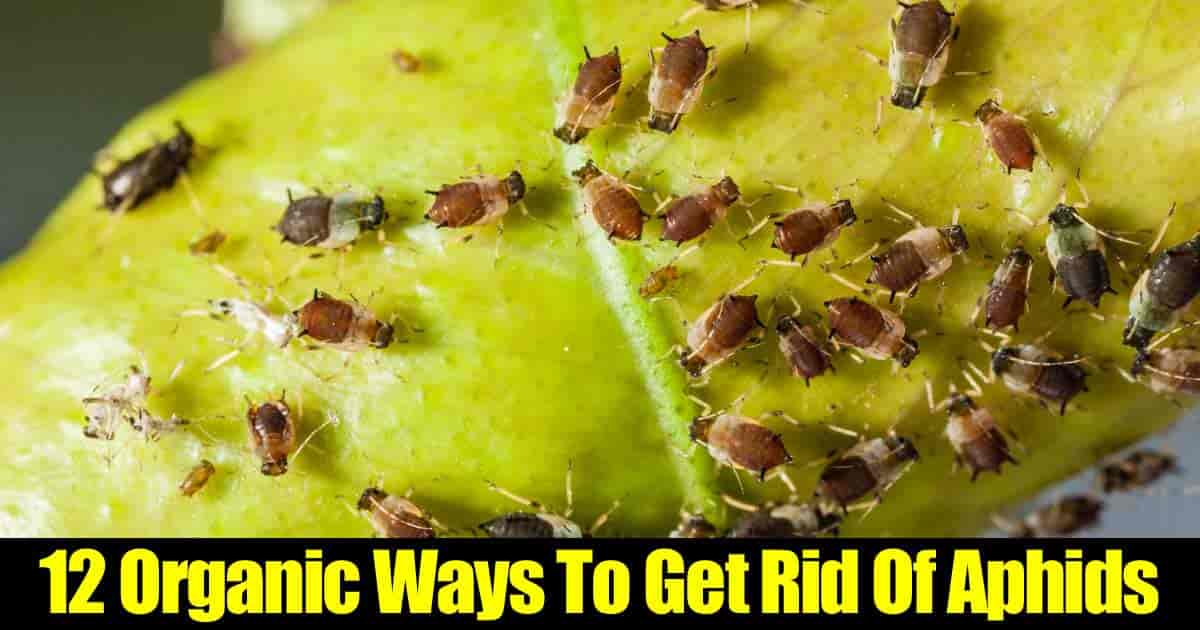
14 Organic Ways Get Rid Of Aphids Naturally
#1 – Get Rid Of Aphids By Picking Them Off!
If you notice a few aphids on your plants, get rid of them by picking them off right away. If you have a minor infestation this may be all you need to do.
If you have quite a few aphids, you’ll want to put on a pair of close-fitting gloves to pinch them off and brush them away.
#2 – Remove Affected Plants
Home remedy for aphids:
If your aphid infestation only has an impact on a few branches or a few plants, remove these. Keep individual plants quarantined and begin killing aphids with soapy water.
If you have pruned away a few infested branches, put them in a bucket of soapy water for aphids to soak and kill off the aphids. Alternately, if you have a burn pile you might want to burn these branches.
Removing the food source of the aphids and any garden pest is key to pest control. No food – no Eat!
#3 – Hose Them Down!
With established plants, a vigorous blast of water from a garden hose can knock off a small aphid infestation. This is a good follow-up after picking individual aphids off mature plants.
Blasting small or young plants with water is not a good idea as it may damage or kill them.
#4 – Get Rid Of Aphids By Spraying Them With A Dish Soap!
Dish soaps dissolve the waxy coating protecting aphids’ bodies. With this coating gone the pests become dehydrated and die very quickly.
You don’t have to make a strong insecticidal soap solution. Just a couple of tablespoons of dish soap in a quart of water sprayed directly on the aphids will kill them.
Be careful about spraying this insecticidal soap everywhere because it will also kill good insects along with any natural enemy and aphid predators such as the ladybug, praying mantis and the like.
Use an insecticidal soap solution only specific on aphid infestations you can see.
#5 – Get Rid Of Aphids With Neem Insecticide Oil
Neem oil is a natural antifungal, antibacterial and insecticidal oil that can be added to your soap concoction or used instead of dish soap in the same way.
Neem oil not only kills aphids, it also repels them.
Organic Natural Neem Oil
Neem oil is our favorite go-to natural insecticide. Unfortunately, like the soaps it is unfriendly to good garden bugs so use it sparingly. Learn more about How to use Neem oil on plants and its many benefits here. You can also purchase Neem at Amazon.
Learn More
If you click this link and make a purchase, we earn a commission at no additional cost to you.
#6 – Essential Oils For Aphids Can Also Be Used In Much The Same Way As Neem Oil And Dish Soap
Use essential oils by adding half a dozen drops each of rosemary, thyme, peppermint and clove oils to a quart of water to make an excellent aphid killing, spider mite killer and repelling spray.
As a bonus, you can also spray this on yourself to repel insects such as mosquitoes.
Read more on: Getting rid of spider mites organically
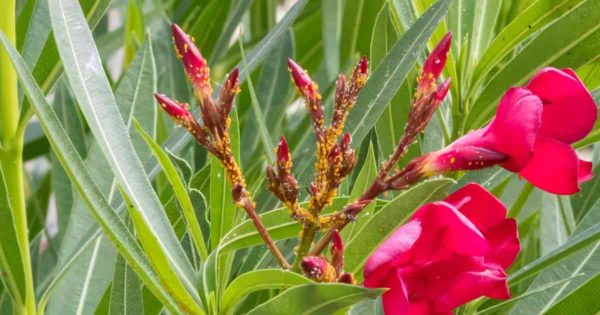
#7 – Get Rid Of Aphids By Maintaining A Healthy Population Of Beneficial Insects
When you have reduced your aphid population, try introducing some beneficial ‘bugs’ to your garden.
You can purchase ladybugs or lady beetles (hippodamia convergens) online and sometimes from your local garden center.
Natural predators like green Lacewings (sometimes called aphid lions) eat aphids, and you can purchase them or their eggs to populate your garden.
Aphid midge larvae are voracious aphid killers. A single larva can eat 65 aphids per day. Their strong jaws and paralyzing toxin help reduce aphid populations.
Hoverfly larvae maggots consume hundreds of aphids and other soft-bodied insects such as scale insects and thrips.
Parasitic Wasps lay eggs in aphid colonies. As the wasps’ larvae hatch, it slowly weakens and kills the aphids. And the aphids as the wasps pupate become an “aphid mummy.” [source]
You can also naturally attract beneficial predator insects to your garden by planting fragrant herbs throughout the garden. Some of the best choices include:
- Oregano
- Yarrow
- Fennel
- Garlic
- Catnip
- Clover
- Mint
- Dill
Be advised if you have cats or if cats roam your neighborhood; you should leave the catnip out of this mix!
#8 – Repel Aphids With Plants
Just as you can attract beneficial insects to your garden with fragrant herbs, you can repel aphids with plants such as garlic and onion.
Create your own garlic spray for aphids at home.
As a bonus, the flowers of these plants will also attract beneficial garden insects.
#9 – Get Rid Of Aphids By Keeping The Ants Away!
As we have said, honeydew (sticky substance) attracts ants and sooty mold, and the ants tend to be very protective of their aphid herds.
Ants may even interfere with birds being able to eat aphids, so it’s a good idea to prevent them ever discovering there are aphids on your plants.
You can help keep ants away by distracting them with baited traps on the ground and at the base of infested plants.
A jar lid containing a few drops of honey or sugar water should do the trick.
#10 – Create A Habitat For Birds!
Remember having a healthy bird population in your garden is a good way to keep the insect pests down. This includes aphids!
The best birds for eating aphids are small ones such as titmice, chickadees and wrens. Attract them by providing bushy hedges and small trees for them to nest and hide in.
Some good choices include hydrangeas, privet hedge, and boxwood plants.
Place birdhouses strategically and provide birds with foods such as shelled or black oil sunflower seeds to attract them and keep them present so they will also eat your aphids!
#11 – Distract The Aphids!
Along with all of your other strategies, you might also plant a decoy garden to draw the aphids away from your other plants.
A lovely, colorful garden of asters, the cosmos plant, dahlias, and zinnias is sure to draw aphids!
You can follow the ants’ example and cultivate your aphids in this area so there will always be plenty of good food for your bird population.
Additionally, you should be advised that these plants should not be intermixed with your other plants as they will tend to increase your aphid problem.
#12 – Keep Your Plants Healthy!
Be sure you understand the care requirements for all of the types of plants you grow. Strong healthy plants naturally repel aphids and disease.
#13 Control Garden Pests With Diatomaceous Earth
Food-Grade Diatomaceous Earth is very pest control solution on soft-bodied insects like aphids. The fine-powder slices the outer layer of the aphids soft-body as they crawl on the DE killing the pest through dehydration.
#14 – Get Rid Of Aphids With A Cayenne Pepper Mix Spray
Use cayenne pepper to control aphids and other small garden pests
In one cup of water mix one teaspoon of Cayenne pepper or blend one hot Chile Pepper in one cup of water.
Spray and cover the insect pests with the cayenne pepper spray solution
Stay In Balance!
Learn from the balance of nature. Aphid pest control is not a one-step process.
While you could spray a systemic insecticide all over your yard and kill aphids off, they would simply come back again when the poison wears off.
It is far wiser to create a balance by targeting aphids when you see them, cultivating a good population of beneficial insects and birds and creating distractions to keep the aphids away from your most prized plants.
2 Homemade Aphid Sprays For Vegetables And Plants
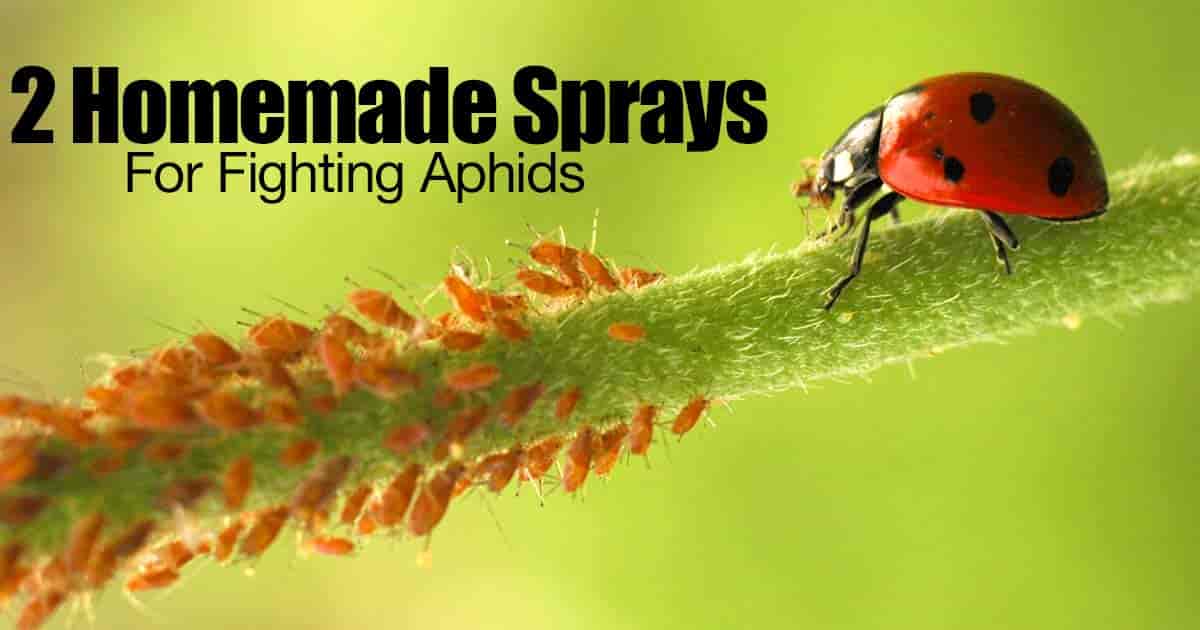
Organic gardeners have used homemade sprays in fighting aphids and mealybugs for generations. Below you’ll find two DIY organic aphid sprays made from tomato leaves and another from garlic.
Knowing how to make and use these sprays use is important, but understanding why they work is equally important. Check out these two organic, homemade aphid sprays.
Organic Aphid Spray Made With Tomato Leaves
The tomato plant a nightshade family member contains alkaloids – a toxic compound found in their leaves.
Chopping the leaves releases the alkaloids. When diluted and suspended in water, they make an easy-to-use homemade spray for fighting aphids. A spray safe for the environment, plants, and humans.
Making The Tomato Leaf Spray
- 1-2 cups of tomato leaves
- Cheesecloth or a strainer
- Two cups of water
- Spray bottle
To make the spray, soak 1 or 2 cups of chopped tomato leaves overnight (depending on the concentration you require) in two cups of water.
Using the fine strainer or cheesecloth strain the leaves out of the mixture. Add two additional cups of water and add it all to the sprayer.
Applying The Tomato Aphid Leaf Spray
When battling aphids completely spray the foliage and stems of infested plants. Make sure to cover the undersides of the leaves as aphids congregate in those areas.
Caution: While safe for plants and humans, some people are allergic plants in the nightshade family. If you’re allergic to them take care when applying this homemade aphid spray.
Aphid Garlic Oil Spray
As a pest-fighting spray garlic mixtures have been used for many years. Garlic contains sulfur which is antifungal and anti-bacterial but also toxic to most pests. When combined with dish soap the mixture breaks down soft-bodied pests.
Making A Garlic Oil Spray
- 3-4 cloves of garlic
- Cheesecloth or strainer
- Mineral oil
- Bottle Sprayer
- Water
- Liquid dish soap (I like Castile soap)
To make the spray, finely chop or mince all the cloves of garlic and add the garlic to 2 teaspoons of mineral oil. Allow the mixture to sit for 24 hours before straining the mixture.
In one pint of water add the remaining liquid. When spraying, mix two tablespoons of the concentrate to 1 pint of water in the sprayer bottle.
Applying The Garlic Oil Spray
Conduct a test-spray in a small area on one part of a plant to make sure the spray does not injure the plant.
If you don’t notice any damage or yellowing of leaves after a day or two, you ahead and spray the entire plant while paying close attention to the undersides of the leaves.
Caution: By being a non-selective insecticide, garlic oil can harm beneficial insects such as ladybugs.
Therefore, used it where no beneficial insects “live” in your garden.
These organic gardening sprays are effective, low in cost and safe for the environment.
Battling aphids is an ongoing process in the landscape and garden. However, scouting out for them and taking action quickly will reduce the impact they can have on your plants.
